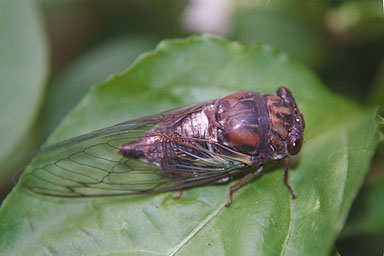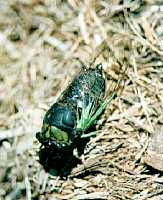

Left: Tibicen robinsoniana; Right: Tibicen chloromera
The most common types of cicadas are actually more often heard than seen. These are the annual or dog day cicadas, most of which are in the genus Tibicen. These insects emerge all over the United States, but are generally more common the farther south you go.
They occur in broods, or year-classes, but they overlap so that there are cicadas present every summer. An adult, like all cicadas, lives only a few weeks, but emergences are staggered so that cicadas are present from about mid-June to as late as early October.
Annual cicadas are large and robust. They vary greatly in color and size. These are a couple of examples:


They also come with green, gold, and red markings. Wing vein coloration varies from species to species, but is usually green or brown. There are many species of annual cicada, each having its own characteristic call. My home state of Arkansas has at least eight distinct species, although most of your insect keys will only give three or four rather generalized models to choose from (and those are supposed to represent the whole country...).
Now for the life cycle. The call is made by males and has two purposes: One is to call other males together; they like to sing in groups. The other, of course, is to attract females. Females lay eggs by using a blade-like ovipositor, or egg tube, to slit twigs and deposit eggs in the resulting crease.
Nymphs hatch about six weeks later, burrow into the ground, and suck on tree roots for a number of years before resurfacing and becoming adults. It is uncertain exactly how many years the cicadas are underground, but it's generally believed to be between 3 and 7 years. Although I don't have any rock-solid evidence, I have a sneaking suspicion that it's 9 years. If someone else discovers this you heard it here first...
I have identified eight distinct species of cicada in Arkansas. I suspect that there are more, but the eight I will describe will be the most familiar anyway. All are believed to be in the genus Tibicen except one. The photos are from the Great Lakes cicada Page for now. This summer I will capture and photograph all eight species myself, to better match each cicada's likeness. I will see that this section becomes more clearly presented as soon as I can find adult cicadas...